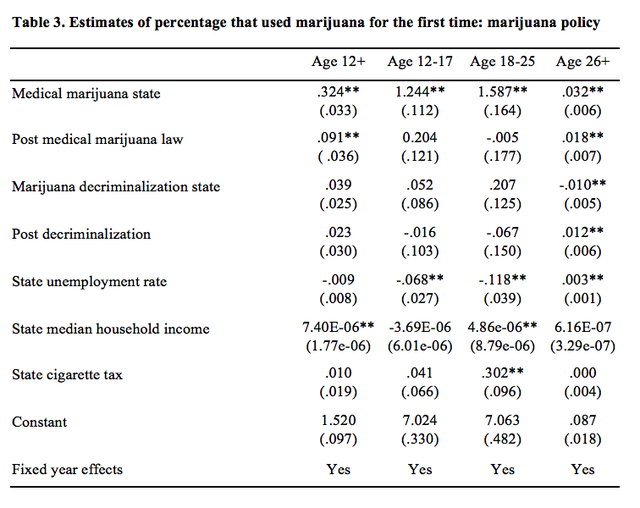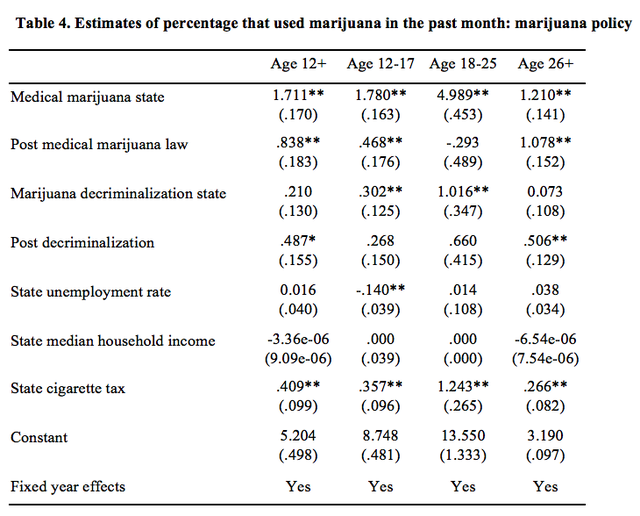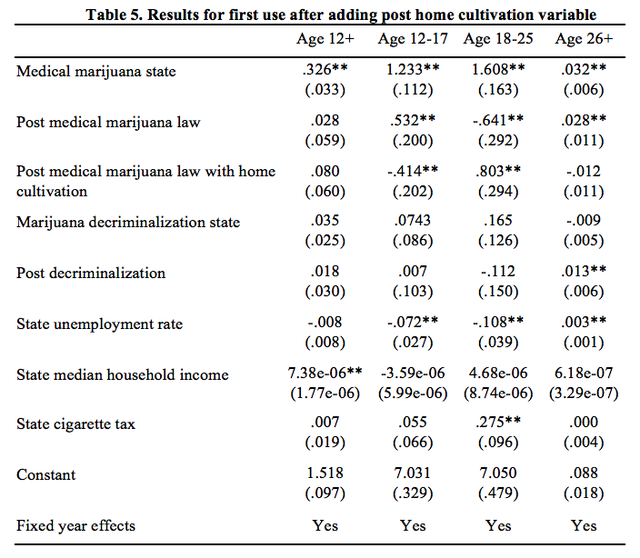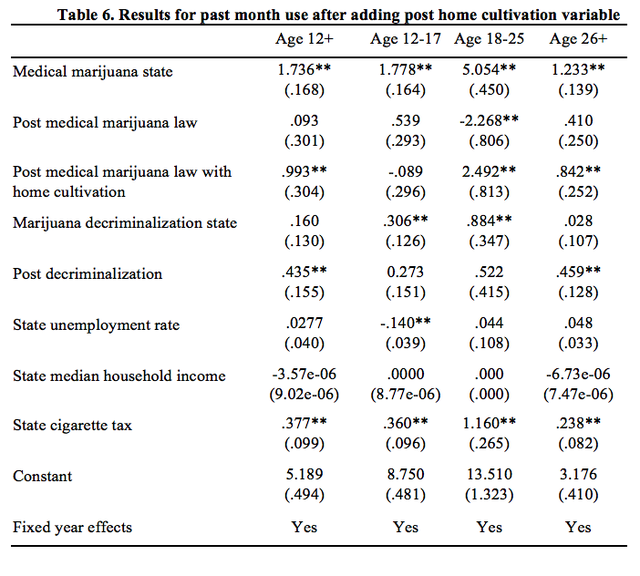From The Developing Economist VOL. 3 NO. 1How Does Medical Marijuana Legalization Affect the Number of Marijuana Users? An Inclusion and Examination of Different Age GroupsVI. ResultsI started off by running the simple model of the regression for both measures of marijuana use. However, adding home cultivation to the regressions and running them again changed the results. After I added home cultivation to the regressions for the total population, legalization was the only variable for which significance changed. However, there were many changes across age groups after adding home cultivation. While I believe home cultivation was a proper specification, some part of the home cultivation model may be causing erroneous interactions between variables. Table 3 shows the differences-in-differences coefficients for the independent variables tested for their effect on the percentage of first time marijuana users in a given state. The coefficient on post-medical marijuana legalization tells us the effect of medical marijuana legalization on first time marijuana use. This coefficient ended up positive and significant at the 5% level. At this point, I rejected the null hypothesis that medical marijuana legalization has no significant effect on first time marijuana use. However, legalization was found to have different significance for different age groups. For those ages 12-17, as well as those ages 18-25, legalization's coefficient was insignificant at the 5% level. The only age group for which legalization had a significant effect was the 26 and older group, but the difference that legalization created in this group's first time use was pivotal in making legalization's effect on the total population significant. Some of the coefficients on the controls had potentially valuable implications. The coefficient for a state having passed a medical marijuana law at any point to this date was positive and significant at the 5% level for all age groups (and would remain so in every regression). This suggests medical marijuana states contain characteristics besides for a medical marijuana law (such as liberal attitudes toward marijuana use) that have a positive and significant effect on the number of first time users in those states. Thus, prior to any exogenous shock, medical marijuana states can be expected to have a significantly higher percentage of first time users than non-medical marijuana states in any given year. Next, the coefficients for belonging to a decriminalization state and the decriminalization law were insignificant on overall first time use, adding support to the idea the theory that penalties on marijuana consumers are largely ineffective. Table 4 contains the coefficients for the same set of independent variables on a different measure of marijuana use, this one being past month use. Once again, the coefficient telling us the effect of medical marijuana legalization was positive and significant at the 5% level. Once again at this point, I rejected the null hypothesis that medical marijuana legalization does not significantly affect past month marijuana use. When breaking down the total population, legalization is found to be significant for 12-17 year olds and 26+ year olds. This suggests medical marijuana legalization has no effect on the percentage of 18-25 year olds that try marijuana or use it on a monthly basis. While the variable of interest (medical marijuana legalization) had the same effect on both measures of marijuana use for the general population, some control variables had different effects on past month use than on first time use. The decriminalization law itself became significant for the total population once I used past month use as the dependent variable, though only the 26+ year olds were affected. This may be attributed to a 26+ year olds being more risk averse than younger populations. Lastly, the state cigarette tax became positively signi ficant for the total population. Perhaps, increased cigarette taxes lead to people substituting occasional cigarette use with occasional marijuana use. Since our results suggested that medical marijuana legalization significantly increases the number of marijuana users, both first time and past month, I wanted to see by what mechanism legalization was driving these increases. The dimension of medical marijuana legalization that I wanted to examine was one of its components for which there is variation across states and that happens concurrently with legalization ~n home cultivation. To see if there was any difference between marijuana laws that allow home cultivation and medical marijuana laws that do not, I simply added a post-home cultivation law indicator to our first time use and past month use regressions. Table 5 shows the coefficients for a set of independent variables that includes post-home cultivation, with respect to the dependent variable of first time use. After adding home cultivation, the resulting coefficient for medical marijuana legalization lost its significance for the total population. It is positively significant for 12-17 year olds and 26+ year olds, which suggests that there is some diversion of marijuana from the legal market to the black market and that 26+ year olds are responsive to legal penalties (meaning I reject my hypothesis for each of these age groups). The fact that these groups were not pivotal in making legalization significant for the entire population suggests that legalization does not increase the number of users in a given state. Though home cultivation itself was insignificant, it seemed to pick up some effects from decriminalization state, decriminalization itself, and unemployment, since they lost their significance for the total population as well. Overall, while adding home cultivation makes medical marijuana legalization insignificant and suggests that we should fail to reject my main hypothesis, there may be some error with this model. This is because the coefficients for medical marijuana legalization's effect on 18-25 year olds, and home cultivation's effect on 12-17 year olds are significant and negative, which is difficult to explain. Table 6 describes the same independent variables as Table 5, but with respect to past month use. Once home cultivation was introduced to the past month use regression, medical marijuana legalization lost its significance on the general population (thus I failed to reject my main hypothesis), with decriminalization itself and state cigarette tax becoming significant. Post-home cultivation ended up being positively significant. Looking across the age groups for legalization and home cultivation has interesting implications. For medical marijuana legalization, the insignificant effect for the 12-17 group suggests there is no significant diversion from adults to minors. On the other hand, only the 18-25 and 26+ groups are significantly affected by post-home cultivation, undermining support for the "social availability" argument that being around growers increases the chances of minors using marijuana in the past month. Similar to the more specified model for first use, this model may be awed since there is a negatively significant coefficient for legalization on 18-25 year olds, which is difficult to explain. VII. ConclusionSince the literature currently focuses on teens, there is not much study of medical marijuana legalization's effect on the general population or specifically its effect on adult age users. Under legalization, the population over the age of 18 is the group that can gain legal protection to consume marijuana with a medical card. Thus examining legalization's effect on this group should reveal just how much, if at all, legal penalties deter marijuana adult consumers. Also, adults can more easily obtain marijuana, and it may be difficult for law enforcement to practically stop them from distributing or sharing with minors. Thus, legalization's effect on adolescent use has implications for the power of diversion from legal market to black market, and for the effectiveness of age-exclusionary measures. My results, after distinguishing between medical marijuana laws with a home cultivation component and medical marijuana laws in their essential form, suggest that medical marijuana legalization does not significantly increase the number of marijuana users or past month users in the general population. For the first use measure, legalization was found to be significant for minors and 26+ year olds, suggesting diversion contributed to first time use by minors and that 26+ year olds are sensitive to legal risk. It is in the past month use regression where the limitations of the home cultivation specification are found: a negatively significant coefficient for legalization on 18-25 year olds suggests some error. One way this study could be improved would be to include a method of controlling for erroneous interactions between different marijuana policy variables. In addition, state-level data on both the first openings of dispensaries, and the number of dispensaries operating in a given year would allow researchers to isolate components of medical marijuana legalization, both supply side and demand side, accurately and assess their effects on marijuana use. References
Endnotes† Author: University of California, Santa Barbara, Department of Economics (anthonyduong@umail.ucsb.edu). Prepared for Economics 196A/B. I thank Professor Shelly Lundberg of UCSB for her expertise and guidance throughout the senior thesis process. I would also like to thank the Economics 196A-B class of 2014 for the helpful feedback for the last two school quarters. All errors are my own.
Suggested Reading from Inquiries Journal
Inquiries Journal provides undergraduate and graduate students around the world a platform for the wide dissemination of academic work over a range of core disciplines. Representing the work of students from hundreds of institutions around the globe, Inquiries Journal's large database of academic articles is completely free. Learn more | Blog | Submit Latest in Economics |





















